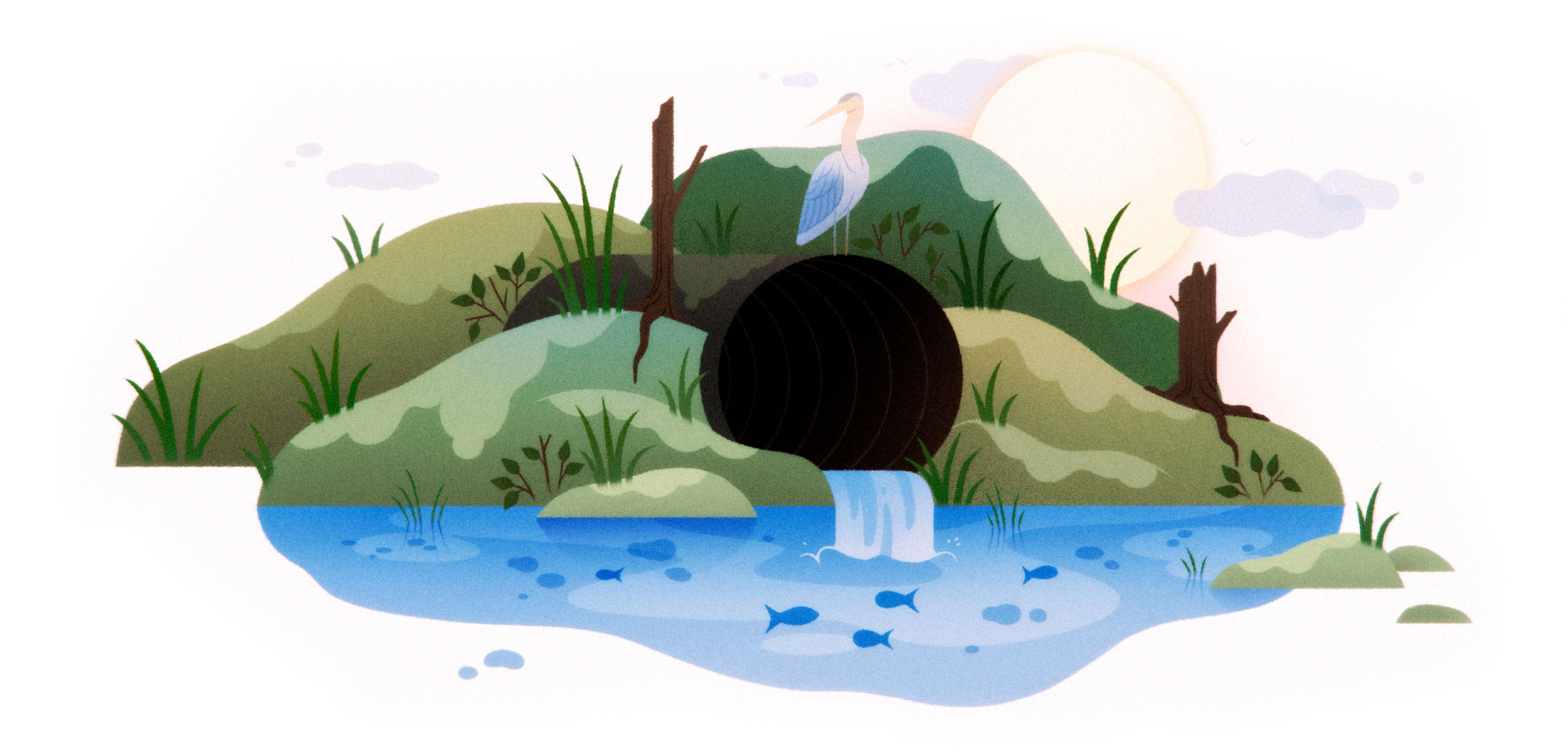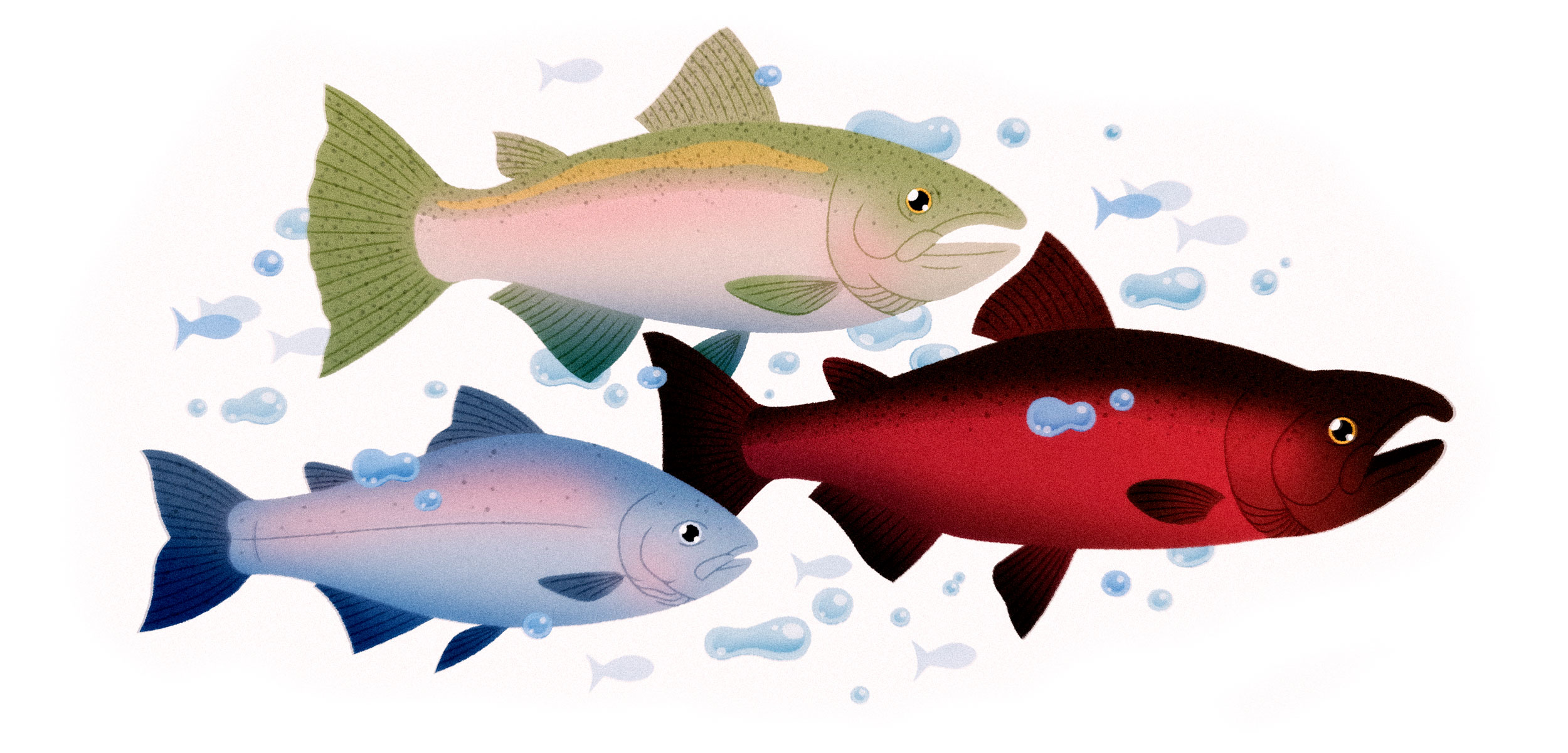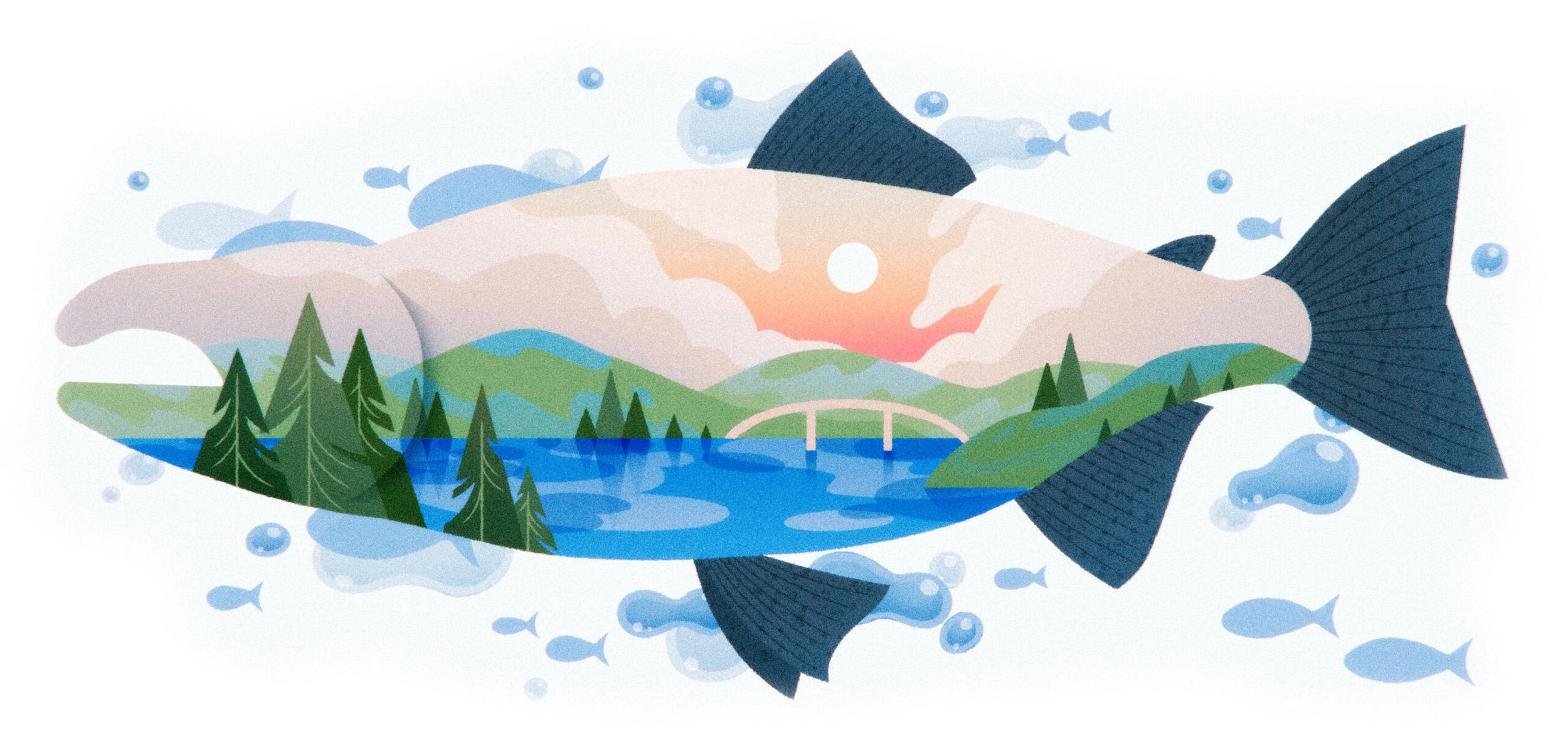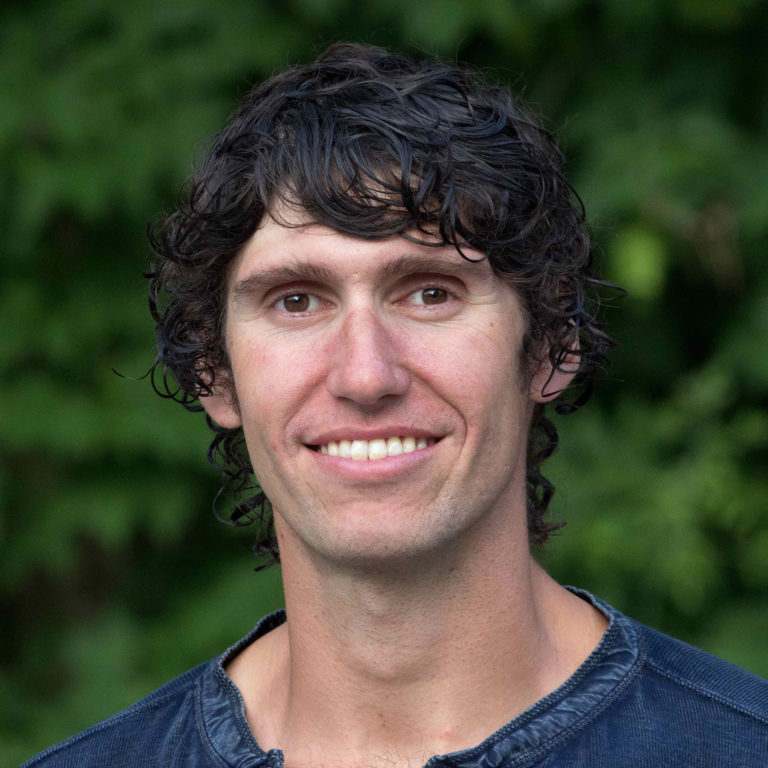This story originally appeared in Hakai Magazine, an online publication about science and society in coastal ecosystems.
Every year, hundreds of muscular, sea-bright fish — chum salmon, chinook, coho, steelhead — push into the Columbia River from the Pacific Ocean, swim over 200 kilometers upstream, and turn left into Hardy Creek. They wend through rocky shallows shaded by alder and willow, cold water passing over flared gills. Plump with milt and eggs, they pump their tails furiously, striving for the graveled spawning grounds in southern Washington State where they’ll complete their life’s final, fatal mission.
And then they hit the railroad.
In the early 1900s, Hardy Creek was throttled by BNSF Railway, the United States’ largest freight railroad network. When the company built its Columbia River line, engineers routed Hardy Creek under the tracks via a culvert — a 2.5-meter-wide arch atop a concrete pad. The culvert, far narrower than Hardy Creek’s natural channel, concentrated the stream like a fire hose and blasted away approaching salmon. Over time, the rushing flow scoured out a deep pool, and the culvert became an impassable cascade disconnected from the stream below — a “perched” culvert, in the jargon of engineers.
“It’s an obvious barrier,” says Peter Barber, manager of the Cowlitz Indian Tribe’s habitat restoration program. “A fish would be hard-pressed to navigate through that culvert.”
The strangulation of Hardy Creek is an archetypal story. Culverts, the unassuming concrete and metal pipes that convey streams beneath human-made infrastructure, are everywhere, undergirding our planet’s sprawling road networks and rail lines. Researchers estimate that more than 200,000 culverts lie beneath state highways in California alone, nearly 100,000 in Germany, and another 60,000 in Great Britain. In Europe, they thwart endangered eels; in Australia, they curtail the movements of Murray cod. In Massachusetts’ Herring River, snapping turtles lurk in culverts to devour passing fish, largely preventing herring from spawning. Taken as a whole, these obstacles are a major reason that three-quarters of the world’s migratory fish species are endangered.

Compared with dams, however, culverts have historically escaped public attention; most people drive over them every day without noticing. “I used to tell people I assess culverts,” recalls Mark Eisenman, a planner at the Alaska Department of Transportation. “They’d say, ‘What the hell’s a culvert?’”
In 2022, however, the US Federal Highway Administration launched a $1-billion program to replace culverts that block oceangoing fish on streams like Hardy Creek — among the largest pots of money ever devoted to these humble pipes. Fixing the countless barriers that underlie infrastructure, according to Barber, is “one of the best ways to restore our salmon runs locally.” But given the sheer scale of the culvert crisis, even a billion dollars will only go so far. Can we repair our faulty culverts while there’s still time to save sea-run fish?
Roads have impeded fish since well before the proliferation of automobiles. In 1893, a log drifted down a tributary of British Columbia’s Fraser River and wedged itself in a wagon-road culvert, preventing sockeye salmon from migrating. So many fish crowded against the jammed pipe that they writhed onto the road, obliging an inspector to “engage men and teams to cart the salmon in order to keep the road clear for traffic,” per one reporter. In 1932, engineers in Arlington Heights, Illinois, found a pair of pickerel caught in culverts, and reportedly “enjoyed a good fish dinner.”
But the real problem wasn’t the few fish caught in culverts — it was the millions who couldn’t swim through them. Early engineers hadn’t given fish a moment’s thought; one 19th-century road-making manual suggested that culverts simply be “large enough to admit a boy to enter to clean them out.” As road systems metastasized throughout the 20th century, the so-called boy standard proved disastrous. As in Hardy Creek, culverts cinched flows into torrents too powerful for adult fish to swim against. Cramped and perched culverts also prevented juveniles from flitting up- and downstream in search of food and refuge. Even as conservationists fretted about megadams and overfishing, roads and railroads were secretly sapping the vitality of coastal streams.
By mid-century, a few scientists had begun to pay attention. After a 1949 report from the Washington Department of Fisheries observed that culverts had created a vast “lost frontier” of foreclosed fish habitat, scientists in Oregon and Washington began retrofitting culverts. Their first attempt was to deploy baffles, rungs that slowed torrential flows into gentle pools, along with angled ramps called fishways. Soon, though, they realized that replacing culverts altogether was far better than retrofitting them. If most culverts failed fish because they were too small, the solution was simple: swap out narrow pipes with wider ones (or, even better, bridges).
Fish biologists came to tout a design known as the stream simulation model — a culvert wide enough to accommodate a waterway and its banks, even during floods, without altering its flows. “The idea is that the river doesn’t know that it’s going through the pipe,” says Eisenman. A gravel floor, rather than a concrete or metal one, completes the effect. “In theory, the fish don’t know when they’re swimming through, either. It just gets a little dark for a while.”
Weighed down by negative news?
Our smart, bright, weekly newsletter is the uplift you’ve been looking for.A few autumns ago, I saw an impressive “stream-sim” culvert in action at Little Skookum Creek near Olympia, Washington. In 2001, a coalition of 21 Indigenous tribes had sued the state of Washington, arguing that its many crummy culverts violated their right to harvest fish in traditional places. The tribes eventually won, and the state’s Department of Transportation began the arduous, court-ordered process of replacing hundreds of salmon-impeding culverts — including the one at Little Skookum Creek. Here, the department had torn out a rusted metal pipe and replaced it with a wider, shorter span more akin to a small bridge. The stream ran through it unencumbered.
The new crossing was anything but glamorous; if I hadn’t known the state had recently installed it, I wouldn’t have thought twice about it. “This is not the most complicated project,” admitted Paul Wagner, at the time a biologist (since retired) with the state’s transportation department and my guide for the day.
Simple, perhaps, but effective. As we watched, a dozen chum salmon finned in Little Skookum’s channel, snouts pointed upstream. Their flanks were barred with electric purple-and-green stripes, their fins ragged with decay. One by one, with the remains of their flagging strength, they kicked their tails and skittered through the culvert to spawn and die. Cars rumbled on the road above them. “It’s pretty cool to see the animals actually using this,” Wagner said. Better culverts struck me as a form of ecological justice, reconnecting the rivers that infrastructure had sundered.

For all the virtues of culvert replacement, however, many transportation departments have been slow to pursue it for the usual reason: money. The Little Skookum Creek project seemed straightforward, but it cost more than $2.7 million, and other streams require far larger fixes. That afternoon, Wagner took me to Coffee Creek, a humble trickle that, decades earlier, had been interred under 30 feet of earthen roadbed where it passed beneath a highway. Rather than excavating all that fill, the agency had decided it would be simpler to reroute the whole stream through a new artificial channel. We stood on a bluff and surveyed the unfinished creek, which lay as bare and muddy as a ditch in drought. The undertaking would ultimately cost around $20 million, Wagner said, sounding a touch rueful. Culverts might be inconspicuous, but they didn’t come cheap.
In 2021, the United States’ culvert-funding shortfall caught the belated attention of politicians. That November, Congress passed the Infrastructure Investment and Jobs Act, a $1.2-trillion package that included money for everything from high-speed rail to electric vehicle charging stations to basic highway repairs. Tucked deep in the law’s thousand-odd pages was a section that attracted little media coverage, but had immense consequences for fish: the National Culvert Removal, Replacement, and Restoration Grant Program.
Nearly a year later, when the program opened for applications, the Cowlitz Indian Tribe’s Peter Barber — a longtime tribal employee, though not a member — was approached by a representative from the BNSF Railway. The company had caught wind of the new funding and wondered if Barber knew of any fish-blocking culverts on their rail line. Barber thought immediately of Hardy Creek.
Together, the Cowlitz Indian Tribe and the railway crafted an ambitious grant application. They proposed tearing out the narrow culvert and swapping in a 33-meter-wide bridge, made of prefabricated parts that the railroad could plug in so quickly that service on the Columbia River line would only cease for 32 hours. The bridge wouldn’t just accommodate the free flow of water and fish, it would also allow the woody debris and fresh gravel to tumble down from Hardy Creek’s headwaters. The gravel would settle downstream, affording adult salmon clean, rocky substrate in which to spawn; the wood would shelter their fry. The old culvert had distorted the stream’s entire structure and ecosystem; a new bridge would set things right.
In August 2023, the Federal Highway Administration announced the recipients of the first round of culvert funding. Among the winners was Hardy Creek, which received the full $5 million that the Cowlitz and BNSF had requested. When I spoke with Barber a few months later, he still seemed astonished. “It was one of those problems that I never thought I would see fixed in my lifetime,” he said.
Hardy Creek found itself in good company. All told, the program’s first cycle gave 59 state, tribal and local governments $196 million to pull out nearly 170 fish-blocking culverts. To no one’s surprise, the bulk of the funding went to Pacific salmonids: There were projects aimed at steelhead in California, chinook in Oregon, and coho in Washington. Some grants are relatively modest in scope — $470,000 to California’s Wiyot Tribe to replace a culvert on Butte Creek, for instance — others immense. The Alaska Department of Transportation got $20 million to replace up to a dozen dilapidated, undersized culverts along the highway that leads to Denali National Park and Preserve, a mammoth restoration project that will benefit all five species of Pacific salmon.
“We have salmon everywhere, we have habitat everywhere,” says the department’s Eisenman. “This lets us start fixing some problems.”
While Pacific salmon were the big winners, eastern fish earned some love, too. The town of Plymouth, Massachusetts, got $2 million to swap out culverts that hamper herring; Maine’s Passamaquoddy Tribe received nearly $8 million to aid a suite of fish that includes sea lamprey and tomcod. The Virginia Department of Transportation got $434,000 to replace a pair of narrow pipes beneath Montague Island Road that prevent shad, blueback herring, alewife and sturgeon from swimming up a brackish channel that goes by the inglorious name of Mud Creek. According to Amy Golden, program manager in the department’s environmental division, the agency plans to install a larger, embedded culvert capable of passing four times as much water as the existing pipe — a culvert that won’t blast away the fish attempting to navigate it.

Mud Creek also illustrates another deficiency of culverts: They frustrate human movements as well as fish migration. Several times a year, says Golden, incoming storm surges overwhelm the Mud Creek culvert and gush onto Montague Island Road, damaging its surface and denying locals access to their homes. This is an increasingly common predicament. Culverts, already the Achilles heels of road networks, are becoming even more vulnerable as the climate changes. They’re swamped by king tides, clogged by landslides and battered by deluges; during 2011’s Tropical Storm Irene, roughly 1,000 culverts washed out in Vermont alone, closing many roads. The same enlarged culverts that help fish are also less liable to get plugged by debris or inundated by storm surges. “We can address a maintenance need, a fish passage need and a resilience need, all at the same time,” Golden says.
Perhaps the most powerful virtue of culvert replacement is that it fundamentally reconnects land and sea. Fish-blocking culverts are forces of disunity that prevent anadromous fish from contributing their oceanic phosphorus and nitrogen to forests, and starve marine predators dependent on healthy stocks. In western Washington’s King County, for example, culverts within the Bear Creek basin have curtailed populations of chinook salmon, a key food source for Puget Sound’s beleaguered killer whales. A grant of nearly $7 million will allow the county to replace three inadequate Bear River culverts — and, with luck, restitch the torn linkages between marine and terrestrial environments.
“We’re allowing those ocean nutrients to once again go up the watershed,” says Evan Lewis, who leads the county’s fish passage restoration program. “Salmon are self-propelled bags of fertilizer.”
Around the world, other countries are also kicking lousy culverts to the curb. In France, faulty culverts have been torn out for the sake of Atlantic salmon and brown trout; in New Zealand, they’ve been removed for smelt, eels and torrentfish. In British Columbia, home to more than 90,000 fish-blocking culverts, a host of conservation groups and government agencies is developing a strategic plan to remove the most egregious blockages. The United States is leading the charge, but its $1-billion culvert replacement program is no piscine panacea. The Washington State Department of Transportation recently estimated that it would cost around $7.5 billion to deal with the hundreds of fish-blocking culverts it’s required to fix on behalf of Indigenous tribes — to say nothing of perhaps 20,000 more on roads owned by counties, towns and private entities.
The program is also limited by geography. Although the only culverts eligible for funding are those that obstruct sea-run fish, many landlocked species also migrate. In the Great Lakes region alone, perhaps 250,000 culverts confound suckers, pike, brook trout and other freshwater denizens. These fish won’t benefit from federal largesse, yet they need help as surely as any coho or chum.
Moreover, culverts so thoroughly warp streams that their damage isn’t easily undone. In Hardy Creek, decades’ worth of sediment has gathered above the BNSF Railway’s culvert; when the blockade comes out, the stream will be free — along with several tons of accumulated silt. Culvert removal thus can’t proceed until the Cowlitz Indian Tribe also installs log jams to capture the liberated sediment; otherwise, Barber says, downstream eggs and fry could suffocate. What’s more, after the railroad culvert comes out, Hardy Creek’s salmon will still face another impassable pipe beneath a state highway just upstream. (Barber hopes to eventually replace that one, too.) Ponder the culvert crisis too long, and it quickly swells to intractable proportions.
Like many wicked problems, there’s only one way to tackle culverts: one pipe at a time. Sometime in the near future — two years from now, or three, or five — a female chum salmon, battle-scarred and tattered with incipient death, will power up Hardy Creek. She’ll pause to rest in the pools behind woody debris and inspect new gravel beds that have settled below riffles. Libidinous males will gather in her wake. At some point in her quest, she will swim up a stretch of newly reconstructed channel and beneath a capacious railroad bridge where once a culvert stood. With luck, she’ll never notice.
This article first appeared in Hakai Magazine and is republished here with permission. Read more stories like this at hakaimagazine.com.





